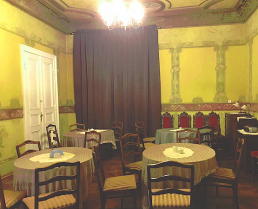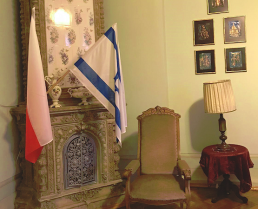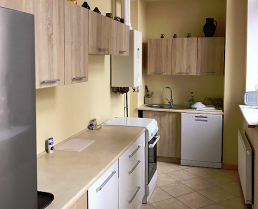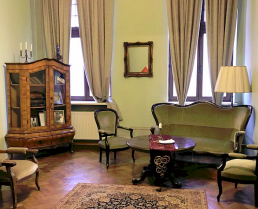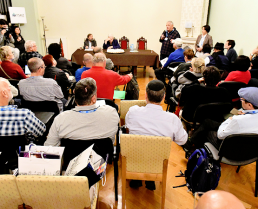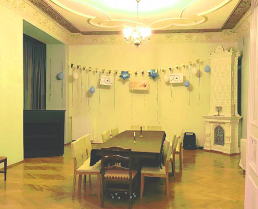The Częstochowa Jewish Club (TSKŻ)
The Social-Cultural Association of Jews in Poland - Częstochowa Branch
- Towarzystwo Spoleczno-Kulturalne Żydów w Polsce (TSKŻ)
The TSKŻ (The Social and Cultural Association of Jews in Poland) was established in 1950 with the aim of fulfilling the cultural needs of the Jewish community of Poland, and to represent its interests.
It has regional branches in Warsaw, Wrocław, Łódz, Katowice, Bielsko Biała, Gliwice, Zary, Wałbrzych, Lublin, Szczecin, Kraków, Legnica and, of course, in Częstochowa.
If you’re visiting Częstochowa, you will always be made welcome at the TSKŻ. Our contact details are on the right-hand side of this page.
CONTACT US:
Towarzystwo Spółeczno-Kuturalne Żydów,
ul Katedralna 8,
42-200 Częstochowa
(First floor of the Częstochowa Jewish Museum)
Email: czestochowa@tskz.pl
Chairwoman:
Izabela Sobańska-Klekowska
If visiting Częstochowa
please email in advance
to arrange a get-together!
The Jewish Cemetery Today
The Częstochowa Jewish Cemetery Today
- the third largest Jewish Cemetery in Poland
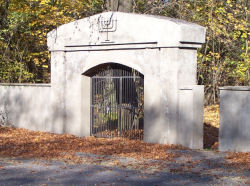 The Częstochowa Jewish Cemetery dates back to the late 18th Century. It is the third largest Jewish cemetery in Poland, containing around 4,500 graves in an area of about 8.5 hectares. The last burial here took place in 1973.
The Częstochowa Jewish Cemetery dates back to the late 18th Century. It is the third largest Jewish cemetery in Poland, containing around 4,500 graves in an area of about 8.5 hectares. The last burial here took place in 1973.
During World War II, the cemetery became the site of numerous mass executions. Not only were partisans killed here, but men, women and children who were deemed unfit for work were also murdered on this site.
Sadly, o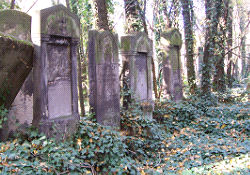 ver time, the general condition of this cemetery has deteriorated. With the demise of its previous owner, the Częstochowa Żydowska Gmina, no one, until now, has been prepared to take the responsibility of restoring this sacred site to a state appropriate to its sanctity.
ver time, the general condition of this cemetery has deteriorated. With the demise of its previous owner, the Częstochowa Żydowska Gmina, no one, until now, has been prepared to take the responsibility of restoring this sacred site to a state appropriate to its sanctity.
In time for our Fourth Reunion in October 2012, the Mayor of Częstochowa, Krzysztof Matyjaszczyk, and the Częstochowa City Council surprised us by not only restoring the Cemetery gates, but also by restoring the central memorial monument to an even better condition than its original state.
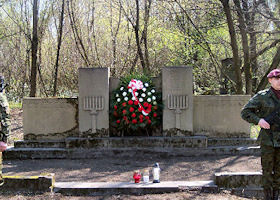
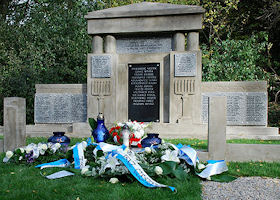
Our recent years, thanks to World Society Vice-President and Chairman of the Association of Częstochowa Jews in Israel Alon Goldman, groups of students have been coming from Israel, and together with local students, have been working on creating an inventory of graves and have done massive clean-ups of major sections of the cemetery. Pictures of their past good works have featured in the NEWS section of our website – they will again!
In 2012, the Częstochowa Museum published the first volume of a major inventory of the cemetery graves which was created by Wiesław Paszkowski of the Częstochowa Municipal Archives.
Nearly all of us have relatives buried in this sacred ground and we ALL have the obligation to ensure that their final resting place is dignified and appropriately maintained. In the future, we will be calling upon landsleit to contribute towards the completion of this project.
Częstochowa Tourist Map
Częstochowa Tourist Map
Jewish & General Sites of Interest
Click on any map marker for more information about that site.
View Czestochowa Tourist Map in a larger map
The map above shows the locations of both Jewish and general interest.
The shaded areas represents the two Częstochowa ghettos:
- The “Big Ghetto” – the light-green shaded area
- The “Small Ghetto” – the dark-green shaded area
The markers denote specific sites. They are listed below and correspond, roughly, to the map, listing them from left to right and from top to bottom. They are:
- Jasna Góra Cloister – housing the Black Madonna icon
- Mercure Patria Hotel – the base for the World Society’s Reunions
- TSKŻ – the Social and Cultural Association of Jews in Poland
- Jewish Gimnazjum – Jewish High School (later moved to ul Jasnogórska 8/10)
- The Częstochowa Museum – the Old Town Hall (Stary Ratusz)
- The Częstochowa City Hall – and administrative offices
- Dr Filip Axer’s Jewish Gimnazjum – private Jewish secondary school
- Częstochowa Historical Doumentation Centre
- The HASAG-Pecery Slave Labour Camp memorial
- The Moebellager – Jewish children were hidden here
- The Częstochowa Philharmonic Hall – once the site of the New Synagogue
- The Kawia Street Place of Execution
- Kula Cemetery – Jews have been buried here since the 1970’s
- The Mikveh
- The Jewish Museum of Częstochowa
- The Old Synagogue – destroyed by the Nazis in 1943
- The Częstochowa Umschlagplatz
- The National Archives in Częstochowa
- The Częstochowa Jewish Cemetery
The Jewish Museum of Częstochowa
The Jewish Museum of Częstochowa
ul. Katedralna 8 (in the Old Town)
Our exhibition has a permanent home thanks to the Częstochowa Mayor and City Council
and the Częstochowa Municipal Museum and Municipal Archives.
OPENING HOURS
Monday: Closed
Tuesday: Closed
Wednesday: 11.00am – 5.30pm
Thursday: Closed
Friday: 9.00am – 3.30pm
Saturday: 11.00am – 5.00pm
Sunday: Closed
A Biographical Guide to the Częstochowa Jewish Cemetery
A Biographical Guide to the Częstochowa Jewish Cemetery
The first volume of a biographical guide to the Jewish Cemetery of Częstochowa has been published by the History of Częstochowa Documentation Centre of the Museum of Częstochowa.
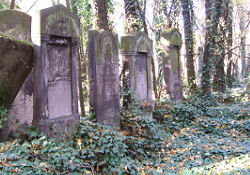 The book contains a register of identified tombstones, short footnotes about the deceased and detailed biographies of more notable people buried in this necropolis. War-graves have been specifically highlighted. The guide also contains information about graves where, today, tombstones no longer exist or where the engraving on existing tombstones has completely eroded.
The book contains a register of identified tombstones, short footnotes about the deceased and detailed biographies of more notable people buried in this necropolis. War-graves have been specifically highlighted. The guide also contains information about graves where, today, tombstones no longer exist or where the engraving on existing tombstones has completely eroded.
This book is the first attempt at such a study. The authors have used both library and archival sources. They have collected data from both Polish and Jewish periodicals as well as works in Polish, German and Yiddish.
They also took advantage of a Polish inventory carried out in 1970-1975. At that time, every gravestone received its own number, however that inventory only listed the Polish-language inscriptions. In 1997, coordinated by Benjamin Yaari, a group of young Israelis, together with Martyna Strachel, Ada Holzman, Uri ben Zion and Michael Chen, listed over 2,000 monuments. Unfortunately, this work was incomplete, contained many errors and inaccurately recorded many names and dates. The authors of this guide have also utilised the results of both inventories.
Due to time constraints and the difficult or impossible access to many graves, the authors’ research within the cemetery itself has been limited. It did allow them, however, to correct and supplement the existing inventories.
This is the first attempt at work on this topic, because published material is limited and, not infrequently, in a “raw” state. The guide will, however, be continued in the form of a second edition or even a second part – depending upon how it is received by its readers and upon whether there is a demand for further work.
For this reason, we are asking for information to be sent to us about people buried in the Jewish Cemetery of Częstochowa, as well as photographs of both the people and also of their tombstones (if available). We also request information about the history of the cemetery itself.
| Our Address: Muzeum Częstochowskie Ośrodek Dokumentacji Dzieów Częstochowy, al. NMP 45a 42-200 Częstochowaemail: oddc@o2.pl |
The Authors:
Dr.Julius Sętkowski is an historian, having studied the 1905 Revolution. He is the author of monographs about the fighting-organizations of the Polish Socialist Party in the Częstochowa district and is also the author of two guides on the Częstochowa Catholic Cemeteries on Kula Street (including the sections of other faiths contained therein and the Evangelical Church section in Roch Street). He works at the Museum of Częstochowa, is Director of the History of Częstochowa Documentation Centre and heads the editorial team which is prepared the expansive “Encyclopaedia of Częstochowa”.
Wiesław Paszkowski was on the team to that prepared both the album “The Jews of Częstochowa – Coexistence, Holocaust, Memory” and the exhibition “The Jews of Częstochowa”. He is the author of articles on the history of Jewish education in Poland and on the state of research into the extermination of Częstochowa Jews. He works at the Museum of Częstochowa.
Częstochowa Tour Guides
Częstochowa Tour Guides
 If you intend visiting Częstochowa and need a tour guide, then Częstochowa’s Jan Długosz University can help you! The university has established a service which offers student-guides who are both English-speaking and well-versed in the history of Jewish Częstochowa.
If you intend visiting Częstochowa and need a tour guide, then Częstochowa’s Jan Długosz University can help you! The university has established a service which offers student-guides who are both English-speaking and well-versed in the history of Jewish Częstochowa.
In fact, these guides can help you while you travel throughout the region between Częstochowa and Kraków.
All guides have been trained by our own Dr.hab.Professor Jerzy Mizgalski, a professor at Jan Długosz University, and Wiesław Paszkowski of the Częstochowa Municipal Archives.
This service came about at the initiative of Dr.hab.Professor Mizgalski and Alon Goldman, Chairman of the Association of Częstochowa Jews in Israel. Alon Goldman will act as a consultant to the service, working with the Service Co-ordinator, Malgorzata Lacka-Malecka.
The service’s guides can provide tourists with an introduction to the city’s history and culture of the entire region between Częstochowa and Kraków, with particular emphasis on the history and contribution of the Jewish population to the development of Częstochowa.
Your sightseeing programme can be tailored according to your needs and to specific sights, streets or regions which you may especially wish to visit.
To avail yourself of this service,
please contact Guide Service Co-ordinator, Dr. Malgorzata Lacka-Malecka:
tel: +48 502 11 22 71 or email malgosiamalecka@interia.pl

